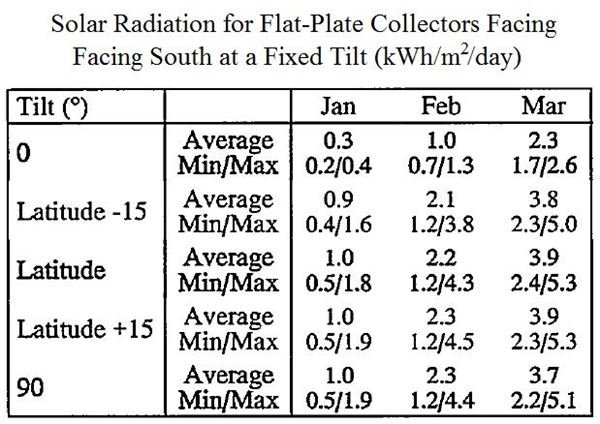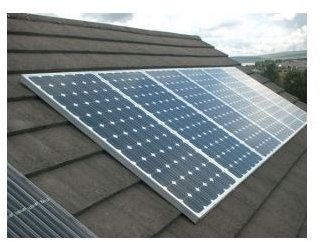Estimate Solar Radiation on Tilted Solar Panels or Surface of Solar Collector
Introduction
Part of planning for and designing a photovoltaic solar power system or a solar thermal system, is estimation of solar radiation on a tilted surface, where the tilted surface is typically a solar panel or solar collector. The main factors that determine this solar radiation rate (or insolation) are the location of the solar panel or solar collector, its tilt angle, and the time of year. There are several approaches to estimating the insolation on a surface at a specified tilt, location and time of year. One of the easiest in the U.S. is to make use of a publication of the National Renewable Energy Laboratory (NREL), Solar Radiation Data Manual for Flat-Plate and Concentrating Collectors, as discussed in this article.
What kind of Solar Radiation Data do You Need?
Solar radiation data can be for extraterrestrial or terrestrial solar radiation; for direct, diffuse or total solar radiation, and for various time periods (e.g. daily average, monthly average, annual average, etc.). Extraterrestrial solar radiation is that striking the earth’s
outer atmosphere, while terrestrial solar radiation is that making it to the surface of the earth. Direct solar radiation reaches the earth’s surface without being intercepted or reflected by anything in the atmosphere. Diffuse solar radiation reaches the earth’s surface after being absorbed and re-emitted or reflected by particles or molecules in the atmosphere. Total solar radiation is diffuse plus direct solar radiation.
If the solar panels or collectors will be at the earth’s surface rather than in outer space, terrestrial solar radiation is obviously what is needed. A flat plate solar panel or solar collector can utilize both direct and diffuse solar radiation, and monthly average solar radiation values are typically adequate for planning and design of solar power and solar thermal systems. Fortunately monthly average, total, terrestrial solar radiation data is available for locations throughout the U.S. in the NREL publication, Solar Radiation Data Manual for Flat-Plate and Concentrating Collectors, as discussed in the next section.
How do I Use the Solar Radiation Data Manual for Flat-Plate and Concentrating Collectors ?
This NREL manual is out of print, but is available free online at: https://rredc.nrel.gov/solar/pubs/redbook/. This manual contains solar radiation and climate data for 239 locations in the U.S. and its territories. Data for each location is given on a single page. The pages are arranged alphabetically by two letter postal code for the states and territories, and alphabetically by city within the state or territory. The manual was prepared from data collected over the period from 1961 - 1990.
There are several types of solar data useful for solar panels or solar collectors in the manual. The only part to be considered in this course is the data for ‘Solar Radiation

for Flat-Plate Collectors Facing South at a Fixed Tilt (kWh/m2/day)’. This data is in the uppermost of five data tables on each page. A major component of the data is monthly average values for solar radiation on a tilted surface, with five different tilt angles from the horizontal: 0o, latitude - 15o, latitude, latitude + 15o, and 90o. A yearly average value for each tilt angle and minimum and maximum values over the 29 year period of record are also given in the table. The Jan/Feb/Mar portion of the table for Anchorage, AK, is shown in the table at the right.
There is a rationale for the tilt angles given in the table. A tilted surface will receive the maximum annual solar radiation with a tilt angle approximately equal to the site latitude. Similarly the best solar panel or solar collector tilt angle for the winter season is about 15o greater than the site latitude, and the best tilt angle for the summer season is about 15o less than the latitude. Data for a 90o tilt angle would be for a vertical surface like a window in a building, and a 0o tilt angle would be for a horizontal surface.
Example
Problem Statement: Find the monthly average rate of solar radiation on a tilted surface at an angle of 76o from the horizontal at Anchorage, AK, in March. Note that the latitude of Anchorage, AK is 61.17o North.
Solution: The given 76o tilt angle is approximately equal to 15o plus the latitude of Anchorage, AK. From the NREL manual, table portion given above, the monthly average asked for is 3.9 kWh/m2/day.
Reference and Image Credit
Website for download of Solar Radiation Data Manual for Flat-Plate and Concentrating Collectors - https://rredc.nrel.gov/solar/pubs/redbook/
Solar Panel image - https://preparednesspro.wordpress.com/2009/04/17/bring-on-the-sun/
About the Author
Dr. Harlan Bengtson is a registered professional engineer with 30 years of university teaching experience in engineering science and civil engineering. He holds a PhD in Chemical Engineering.
This post is part of the series: Estimating Solar Radiation to a Solar Panel or Solar Collector
Part of planning for a pv solar power or a solar thermal system is estimation of the solar radiation on a tilted surface, that is on a solar panel or a solar collector. Online resources can help with this estimation for a flat-plate solar panel or collector or for windows in a passive solar system.
